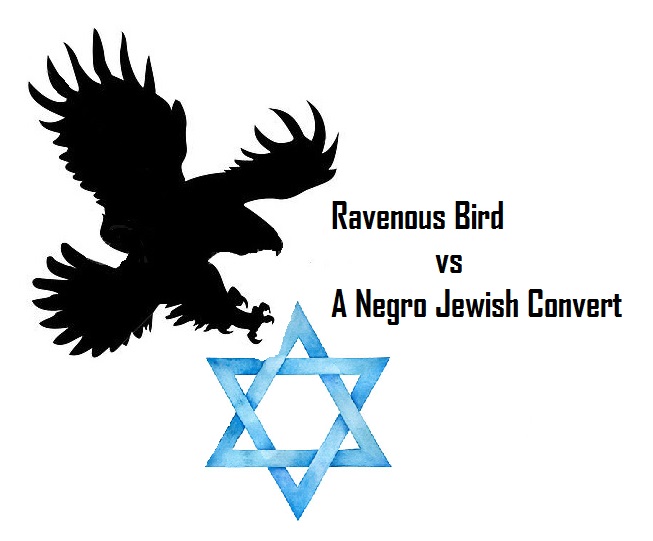
Danny Vacciana asks: 1. Can we have a full list of artifacts you used, along with the academic papers you used, along with the transliterations you used to reconstruct the vocalization of Ghabaray from other languages such as Egyptian, Assyrian etc so we can understand this process you used?
Update: Still no response. The silence is deafening.
Ravenous Bird responds: Well, in my defense, some of us are actually occupied doing meaningful things with our lives with the limited time we’ve been given, meaningful things that are having a positive impact upon thousands, and which quite naturally keeps us very busy. Others, on the other hand, are doing nothing meaningful with their lives and are impacting no one at all, and they have all the time in the world on their hands to do nothing meaningful.
Artifacts and sources:
From the royal annals of Tiglath-Pileser III (745-726 BCE), see H. Tadmor, The Inscriptions of Tiglath-pileser III King of Assyria (The Israel Academy of Sciences and Humanities: Jerusalem, 1994). The correct vocalization of the divine Hebrew name YA’OH/יהוה that I proclaim is attested in the Calah Summary Inscription 7 (K.3751, rev. line 11′) from the royal annals of King Tiglath-pileser III which transcribes the biblical Hebrew theophoric name Ya’oh-akhaz/יהואחז (i.e. Jehoahaz). The divine Hebrew name was repeatedly transcribed in 8th century BCE Neo-Assyrian Akkadian inscriptions with two signs, ia-ú, which are vocalized Ya-oh (two syllables divided by an unwritten glottal stop), and where /u/ is transcribing a long O-vowel. For proof that /u/ in Akkadian transcribes long O, see A. Westonholz, “The Phoneme /o/ in Akkadian,” ZA 81 (1991), pages 10-19.

For the correct vocalization of the phoneme [gh]/ע, otherwise known as “ayin,” in the initial position of the biblical personal name Ghamaray/עמרי (i.e. Omri), see Summary Inscriptions 4:6′, 15′; 9:r.4, r.9; and Summary Inscription 13:17′ – all from the royal annals of the same Neo-Assyrian monarch named above. All scholarly grammatical sources dealing with ancient Northwest Semitic languages are in full agreement with me about the usefulness of the 8th century Neo-Assyrian transcriptions of biblical Hebrew words for the recovery of the correct vocalization of ancient Hebrew.
For proof that the biblical word עברי (i.e. Hebrew) actually begins its vocalization with the guttural phoneme [gh]/ע and not with a vowel (as in “Ivri” from the heathen Masoretic Hebrew), see The Assyrian Dictionary of the Oriental Institute of the University of Chicago (CAD). Volume 6, H (1956), pages 84-85. There you will find that the word H̬abiru / H̬apiru (that is, “Gha-bar-ay” aka Hebrew) is attested as a foreign word in Sumerian and Akkadian texts dating as far back as the 3rd millennium BCE. This means it is a loan word from a West Semitic language, and this language quite obviously is the language we now call biblical Hebrew. This evidence proves that the word עברי begins with a guttural consonant and not with a vowel as in “Ivri,” and also that the word is three syllables not two as in “Ivri”. The very late heathen Tiberian Masoretic vocalization of biblical Hebrew and the word עברי is simply wrong.
For an additional affirmation as to the value of the cuneiform inscriptional evidence for determining ancient Hebrew phonology, and for the guttural phoneme [gh]/ע once again, see E. Kautzsch, Gesenius’ Hebrew Grammar (Oxford University Press: London, 1910), §6b and §6e, page 32.
For my position that the biblical Hebrew name Hoshai/הושע (i.e. Hosea), which is represented in Akkadian cuneiform in the 8th century BCE as A-ú-s-i-’i, is vocalized with a long I-vowel (not a diphthong) in the terminal syllable, see again H. Tadmor, The Annals of Tiglath-Pileser III King of Assyria, pages 140-141.
For scholarly agreement with my position on the non-existence of ש/sin, or polyphony in general, in ancient Hebrew and that the language has but one grapheme per phoneme, contrary to heathen Masoretic Hebrew, see Giovanni Garbini, Il Semitico di Nord-Ovest (= Quaderni della sezione linguistica degli annali, I). Napoli, 1960. Istituto Universitario Orientale di Napoli, page 45; also see, Hebrew in It’s West Semitic Setting: A Comparative Survey of Non-Masoretic Hebrew Dialects and Traditions, Volume 16, Parts 2-3 (Brill, 1986), pages 60-61; and Werner Diem, “Das Problem von ש im Althebraischen und die kananaische Lautverschiebung”, ZDMG 124 (1974), pages 221-252.
The polyvalance of graphemes in the Hebrew alphabet is actually a later development of heathen Canaanite dialects which had a larger inventory of phonemes. After adopting the 22 letters of the ancient Hebrew alphabet with its smaller inventory of phonemes, the Canaanites assigned more than one phonemic value to certain graphemes.
As for the Egyptian evidence, the Soleb temple of the 18th dynasty Pharaoh Amenhotep III in Nubia (14th century BCE) attests to: “The Land of the Nomads (shasu) of Yhw3,” which indisputably is a reference to the deity of the Hebrew scriptures. The M17 (double reed) sign is rare as the initial consonant in Egyptian words, but in the transcription of North West Semitic words it is the consonant [y], as per Alan H. Gardiner, Egyptian Grammar. Third revised edition (Oxford: Griffith Institute, 2007), pages 481, 586. The second sign in the deity name is O4 (reed shelter). This is the consonant [h] but according to the “group writing” method used at that time for foreign non-Egyptian words, the signs M17+O4 form a group, and make the first syllable of the foreign Semitic deity name. That syllable is /yah/.
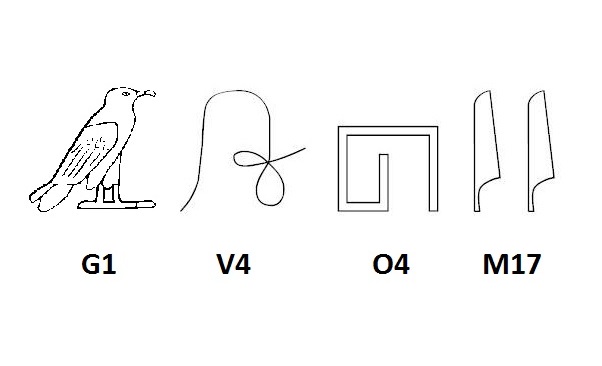
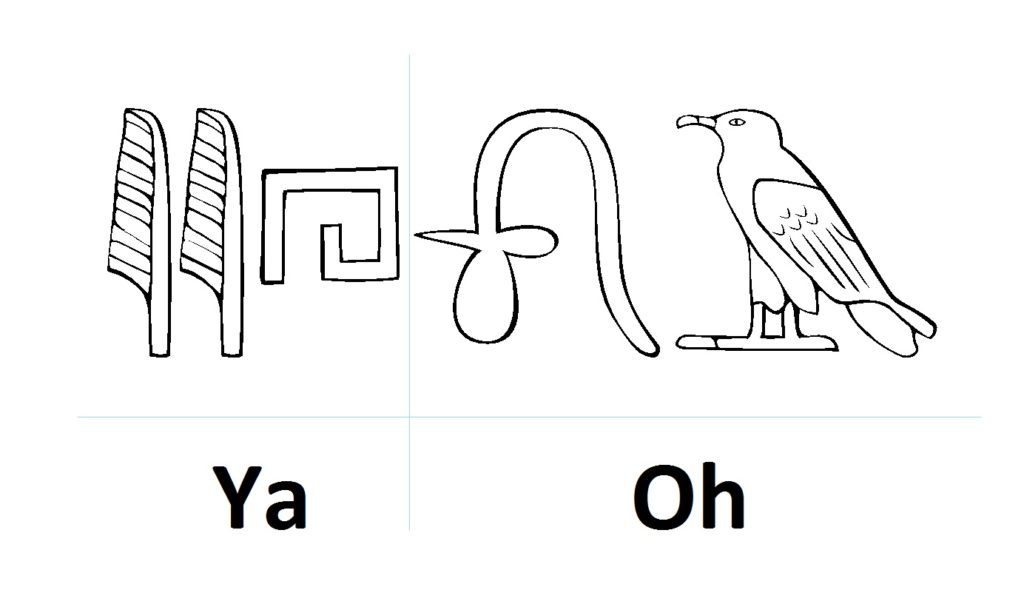
New findings from 2019 show a vocalic V4 (lasso rope) + G1 (falcon) and not a V4 (lasso rope) + G43 (quail chick) is the sign group in the syllabic orthography of the divine name in this Egyptian inscription; see Titus Kennedy, “The Land of the s3sw (Nomads) of yhw3 at Soleb,” Dotawo: A Journal of Nubian Studies 6 (2019), pages 175-192. The vocalic V4+G1 sign group is always rendering an O-vowel in Northwest Semitic words and place-names, whenever this group is in the medial or the final position. This is evidenced by ring name 24 (“Bayth-Horon”), ring name 102 (“Tilon”), and ring name 106 (“Dod”) in the Pharaoh Shoshenq I triumph-scene at Karnak (10th century BCE); see Robert K. Ritner, The Libyan Anarchy (Society of Biblical Literature, 2009), pages 206-210. The foreign Semitic deity name in the Soleb inscription is without question to be pronounced YA’OH (two syllables divided by an unwritten glottal stop) in exactly the same way that much later scribes in Assyria transcribed the divine Hebrew name in Akkadian during the 8th century BCE.
As for evidence during the Greek period that the divine Hebrew name was only pronounced YA’OH, in agreement with the much older Egyptian and Akkadian inscriptions, see R. J. Wikinson, Tetragrammaton: Western Christians and the Hebrew Name of God: From the Beginnings to the Seventeenth Century (Brill, 2015), page 59. See also, F. Shaw, The Earliest Non-Mystical Jewish Use of Iao. Contributions to Biblical Exegesis & Theology (Peters: Leuven, Paris, and Walpole, MA, 2014). These two references discuss, among other things, Diodorus, Bibliotheca historica 1.94.2, and fragment 4Q120 from the Dead Sea Scrolls. The evidence for the pronunciation YA’OH is both abundant and conclusive.
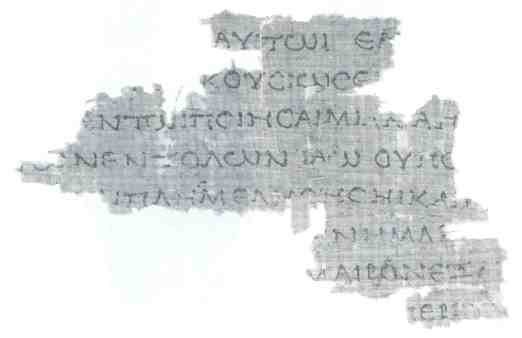
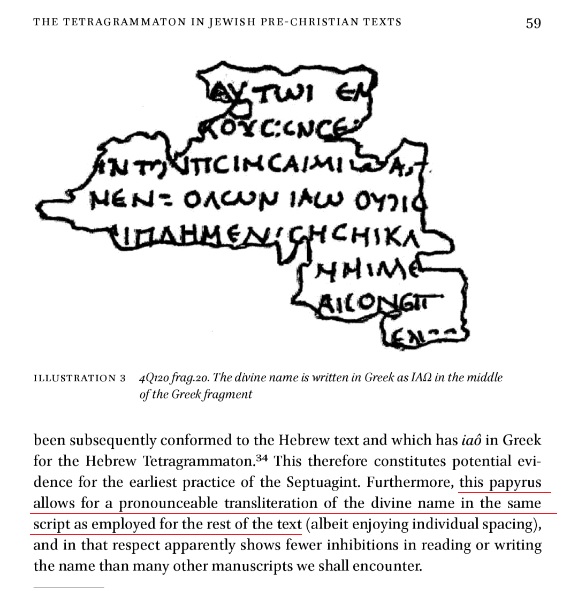
The divine name is the most important word in the ancient Hebrew language. It’s correct pronunciation informs us about how all other words in the language are to be pronounced. The Soleb inscription from the 14th century BCE and the Neo-Assyrian inscriptions from the 8th century BCE listed above prove that the medial [h] is a silent vowel placeholder in the divine name. It follows that the grapheme should always behave as such in other ancient Hebrew words. The argument that the Greek evidence is not conclusive since Greek does not have medial [h] is debunked by the fact that the Greek letter χ was called upon as a substitute for this phoneme, as in αβραχαμ (PDM XIV, 227 = VIII, 8), but αβραάμ in the Greek LXX and in the Greek New Testament. See F. L. Griffith, H. Thompson, The Demotic Magical Papyrus of London and Leiden; t. I, Preface, Introduction, Transliteration, Traduction (Oxford, 1921-1904), page 64; and F. L. Griffith, H. Thompson, The Demotic Magical Papyrus of London and Leiden; t. III (Oxford, 1921-1904), page 113.
I only mention the Greek period evidence because it is consistent with much older evidence, not because it is my only evidence. So for people to say the name I proclaim is only based on Hellenistic period evidence simply shows that they are uneducated and do not have access to sources. For example, long before there was a Greek period, my ancestors living in Elephantine near the border with Nubia during the Persian period were also pronouncing His name as YA’OH. This is proven by the 5th century BCE Aramaic papyri found at Elephantine and discussed by A. E. Cowley, and also more recently by Bezalel Porten.
Thus, in accordance with the way in which the divine name is pronounced, and contrary to heathen Masoretic Hebrew, the phoneme [h] in ancient Hebrew is only vocalized as an aspirated consonant at the beginning of words, or the beginning of suffixes, or as the closing rough breathing sound of a terminal syllable. The very late Masoretic vocalization system is a fabrication and must be repudiated and replaced by a return to a consistent application of matres lectionis, and by that I mean the language writes its vowels out with certain consonants that act as vowel letters and the only inherent or unwritten vowel in the pure language is an a-class vowel.
For scholarly agreement with me that matres lectionis is not a later development of biblical Hebrew, as is commonly thought, but has been part of the language from the very start, see Ziony Zevit, Matres lectionis in ancient Hebrew epigraphs (1980).
For more scholarly agreement with my position on the medial [h] in ancient Hebrew, see the excerpt below from A. E. Cowley, “A Passage in the Mesha Inscription, and the Early Form of the Israelitish Divine Name,” The Journal of the Royal Asiatic Society 2 (1920), page 178.
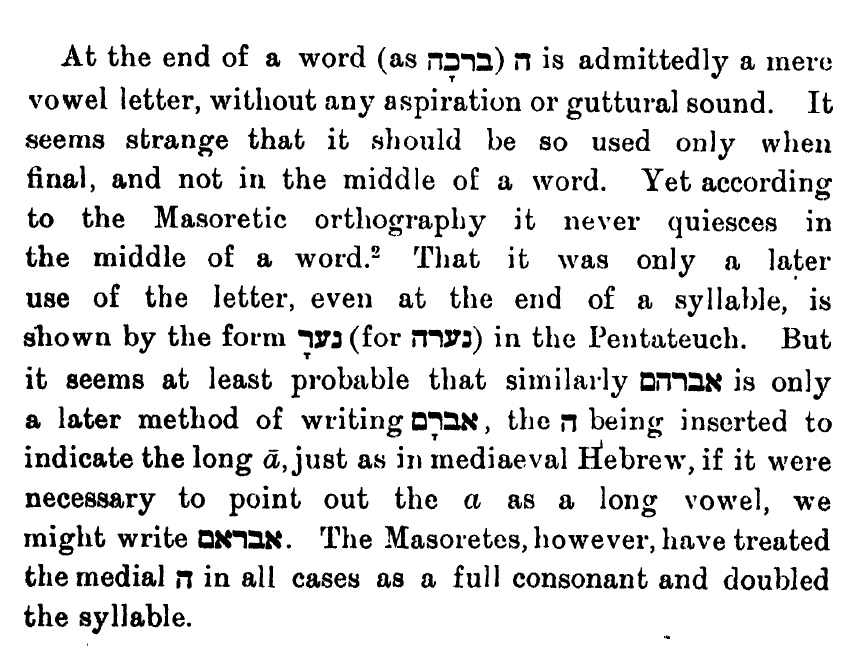
What Cowley says is 100% correct. For the Egyptian evidence that the medial [h] is indeed without any aspiration or guttural sound in the biblical Hebrew name Ab-rahm/אברהם (i.e. Abraham), just as Cowley stated, see again Robert K. Ritner, The Libyan Anarchy (Society of Biblical Literature, 2009), pages 206-210, where the Patriarch’s new name, given to him prior to purchasing a field in Canaan, appears in the toponym-list of the Libyan Pharaoh Shoshenq I at Karnak (10th century BCE) on ring names 71 and 72 (see below). There is no medial [h] sound in his new name אברהם. This name is pronounced Ab-rahm with a lengthened a-class vowel for stress in the second syllable, which is the name’s second element. The name is not pronounced Abraham or Avraham, and it never was until biblical Hebrew ceased being a living language after the 1st century CE. The very late Masoretic vocalization of this biblical Hebrew name is utterly wrong.
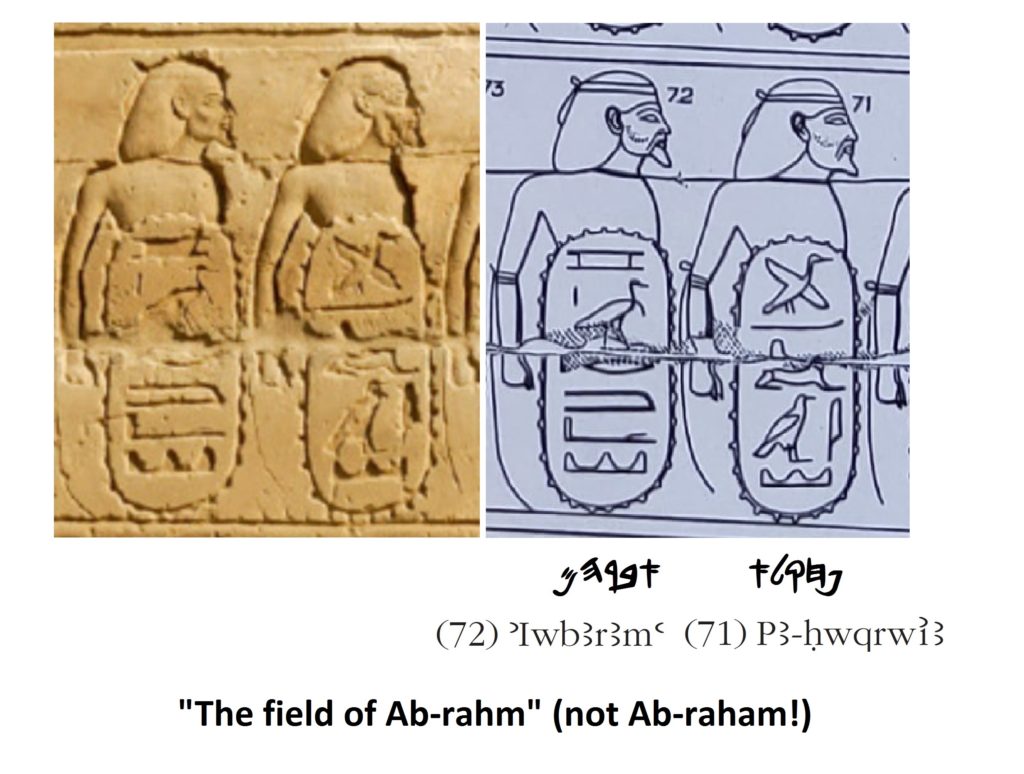
The second element r-h-m in the Patriarch’s new name is also attested in Egyptian, r-m, and this word means “peoples,” “men,” “mankind”. Once again, it has no medial [h] sound and cannot be pronounced as ra-ham. See E. A. Wallis Budge, An Egyptian Hieroglyphic Dictionary. Vol. 1 (London, 1920), page 423. The name Ab-rahm means: “Father of peoples”.

Lest anyone naive and uneducated thinks to question the validity of using the Egyptian evidence to establish ancient Hebrew phonology, take note of the following quote from James E. Hoch: “The Egyptian transcriptions provide valuable information about the phonology of West Semitic Languages, since Egyptian is able to represent some distinctions better than the Phoenician alphabet and Akkadian cuneiform” (Semitic Words in Egyptian Texts of the New Kingdom and Third Intermediate Period [Princeton University Press, 1994], page 11).
Danny Vacciana asks: 2. Can you please explain why you accept the Masoretic text over other texts such the Samaritan or Syriac texts, but reject the Masoretic vocalization?
Ravenous Bird responds: This is an illiterate question. The Thorah that I have written utilizes all of the available textual witnesses of the so-called Old Testament, such as the Dead Sea Scrolls, the Samaritan Pentatuech, the Greek LXX (which attests to a Hebrew text type that is older than the Masoretic text), etc. I reject the very late Masoretic vocalization of ancient Hebrew words for the reasons I state above in response to your first question.
Danny Vacciana asks: 3. Can you please explain why you trust the Masorites regarding their consonants, meaning you accept their consonants word for word as written, but not their vowels as they recorded them? Why not reject them completely?
Ravenous Bird responds: This is yet another illiterate question. The 22 consonantal phonemes of ancient Hebrew are attested centuries before there were any Masorete scribes, so these consonants cannot belong to the Masoretes. The biblical manuscripts copied by the Masoretes also precede the Masoretes by centuries, evidenced by the biblical mss. among the Dead Sea Scrolls, which are a thousand years older than the oldest Masoretic mss. Please ask an intelligent question.
Danny Vacciana asks: 4. Can you please explain why you accept the Masoretic grammar and the translations from the many Hebrew lexicons, all based on the Masoretic vocalization, but reject the vocalization itself?
Ravenous Bird responds: I’ve already answered you as to why I reject the heathen Masoretic vocalization of biblical Hebrew. The grammar of biblical Hebrew is completely independent of the Masorete scribes, that is unless you wish to ignorantly maintain that there was no understanding of biblical Hebrew grammar until the 9th century CE when the Masorete scribes worked from Tiberias. Clearly this shows a dismal lack of familiarity with the language on your part. How did Jerome learn biblical Hebrew grammar in the 5th century CE and translate from Hebrew to Latin in the making of the Vulgate, long before there were any Masoretes? Please educate yourself and ask an intelligent question because the questions you are asking are an embarrassment for you.
Danny Vacciana asks: 5. Can you please subject your findings and process to peer review by known scholars in Hebrew and Semetic languages, or give their contact info if you have already done so, so we can see their findings regarding Ghabaray?
Ravenous Bird responds: I’ve already told you where you may find research papers of mine that have been peer-reviewed. The link is here: https://bu.academia.edu/YaohdaBanDor.
Danny Vacciana asks: 5. Lastly can you please stop acting with negativity and attacks by yourself and your followers on those who merely wish to understand your discovery and how Ghabaray was reconstructed?
Ravenous Bird responds: Let’s not resort to deception and lying shall we? I only attack those who initiate the provocation, which is what you continue to do because you are uneducated and out of your league. Biblical Hebrew is not your area. You are not even fluent in modern Israeli Hebrew. If anyone without provocation throws a pebble at me, I respond with a tactical nuclear missile. That will never change. I am not a Christian and never will be. When you give respect only then will respect be given.
At the end of the day, I am not at all concerned with obtaining anyone’s approval, whether they be scholars like me in my field, or whether they be average people with limited access to scholarly sources. I only care about winning the approval of just one person, and that one person is the deity I serve, the Higher Power who made heaven and earth, the same one who has me proclaiming His name from the islands of the east where the sun rises, in fulfillment of His prophecy.
His name is YA’OH
Always has been. Always will be.
#EXODUS2023
1.15.7252 (April 5, 2023)

And so it goes…YA’OH by His Power, once again and most profoundly and conclusively, has spoken through the mouth of His servant and His prophet Mabayn Ya’ohdah Ban Dor, AKA Ravenous Bird/ha’Ghayt ha’yom ha’zah: That “Shamo YA’OH”. Forever…Halalo ath YA’OH Ghalayon
SHALOM MABAYN GHAYT ,I like the way you handle that joker, it’s clear he really didn’t wanna learn anything from you, he just thought he could run circle around you, a hard working servant of YA’OH our Alah’aym.,first the info you gave him was top notch. Second you handle him very respectful, these so call Israelite camp’s ( bafoons) up here in New York would have probably curse that guy, with fake information to MUDDRAZZ. !!!. TOB MA’AD AKH’AY. Chal Chabod YA’OH.
All resources provided to His chosen prophet are now ending the games of fooled fools. Thodah la’Ya’Oh for Ravenous Bird! Ravenous indeed and impressively, absolutely brilliant!
Is how you politely murder someone?
The Ravenous Bird has given many loaves of bread and not crumbs left from toast to guide the mind and the mind to follow simple instructions. Be it deemed that the loaf of bread he gave unto the visitors came with a recipe and its to be followed in its entirety with no short cuts. The visitors actions were all the same of the loaf of bread at hand and that was, not one loaf was sliced correctly by the recipes standards or was it used at all by the one’s that received it properly. The one’s that received it, butchered it into chunks and allowed the loaf to be then devoured by the air that constitutes to then become hardened over time because they didn’t follow simple instructions on how to utilize the recipe in the first place. The Ravenous Bird doesn’t give bread crumbs from toast, he gives you a whole loaf of bread that has a recipe to follow and when you utilize the recipe step by step, it will then all turn out to be best slices and good to the last drops of crumbs you can still eat and get filled. Anyone that comes in and asks many questions will not leave empty handed. The problem is is that the receivers on the other ends are not listening themselves first of all, second they are not taking notes correctly, third they are not listening to get an understanding, fourth they are not really interested in the truth and of its findings because they are trying to pin point false as their main goals, fifth they are rambling because the seat is very hot and they are not able to sit still or grasp the concepts, sixth they are in no means of letting up off of their own idealology of what they still leave with and feels that they have not received anything from their visit. Finally, and seventh I would do anything if I were them that visited to be apart of Ghâbarāy and its truth, it’s history, most importantly the True Deity’s Name (Yă’ōh) and be amongst His Chosen Remnant Children and their generations to restore, rebuild and recover and come together as the people being one Nation again filled with many 12+1 tribes that came from across the Transatlantic Slave Trades long ago and is now finally returning with Wings as they are being awakened, educated, loved, understood and lead out by Yâ’ōh their Only Sāvior and True Deity, Their Alah’aym and Their Prophet The Ravenous Bird Yâ’ōhdâh Bân Dōr! “You just can’t come to the hot-seat and leave without that loaf of bread recipe”. It has more than crumbs to butter and jam to spread. The aroma and smell will keep you coming back for more and more and more and more! Shalom 💖🕊
Aman akhathay. “..loved, understood..”. Aman wa-aman akhathay. Shalom
Chabod la-YA’OH
Aman.
Let him know wassup 😂
Ravenous Bird , Your intellect is impressive.
You had that negro sweating bullets….
Wow! Mabayn I’d call that a mic drop!
Why you go’na do homie like that…I guess he was asking for it.
Shalom ❤️🕎
Kaboom!!!!!!!!!!